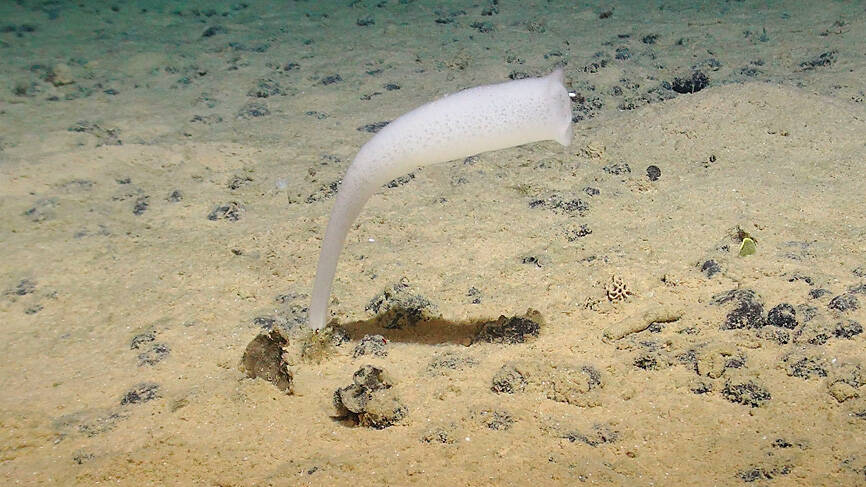Could lumpy metallic rocks in the deepest, darkest reaches of the ocean be making oxygen in the absence of sunlight?
Some scientists think so, but others have challenged the claim that so-called “dark oxygen” is being produced in the lightless abyss of the seabed.
The discovery — detailed in July last year in the journal Nature Geoscience — called into question long-held assumptions about the origins of life on Earth, and sparked intense scientific debate.

Photo: AFP
The findings were also consequential for mining companies eager to extract the precious metals contained within these polymetallic nodules.
Researchers said that potato-sized nodules could be producing enough electrical current to split seawater into hydrogen and oxygen, a process known as electrolysis.
This cast doubt on the long-established view that life was made possible when organisms started producing oxygen via photosynthesis, which requires sunlight, about 2.7 billion years ago.
“Deep-sea discovery calls into question the origins of life,” the Scottish Association for Marine Science said in a press release to accompany the publication of the research.
Environmentalists said the presence of dark oxygen showed just how little is known about life at these extreme depths, and supported their case that deep-sea mining posed unacceptable ecological risks.
“Greenpeace has long campaigned to stop deep sea mining from beginning in the Pacific due to the damage it could do to delicate, deep sea ecosystems,” it said, adding: “This incredible discovery underlines the urgency of that call.
The discovery was made in the Clarion-Clipperton Zone, a vast underwater region of the Pacific Ocean between Mexico and Hawaii of growing interest to mining companies. Scattered on the seafloor 4km beneath the surface, polymetallic nodules contain manganese, nickel and cobalt, metals used in electric vehicle batteries and other low-carbon technologies.
The research that gave rise to the dark oxygen discovery was partly funded by a Canadian deep-sea mining business, The Metals Co, that wanted to assess the ecological impact of such exploration.
It has sharply criticized the study by marine ecologist Andrew Sweetman and his team as plagued by “methodological flaws.”
Metals Co environmental manager Michael Clarke said the findings “are more logically attributable to poor scientific technique and shoddy science than a never-before observed phenomenon.”
Sweetman’s findings proved explosive, with many in the scientific community expressing reservations or rejecting the conclusions.
Since July, five academic research papers refuting Sweetman’s findings have been submitted for review and publication.
“He did not present clear proof for his observations and hypothesis,” said Matthias Haeckel, a biogeochemist at the GEOMAR Helmholtz Centre for Ocean Research in Kiel, Germany. “Many questions remain after the publication. So, now the scientific community needs to conduct similar experiments etc, and either prove or disprove it.”
Olivier Rouxel, a geochemistry researcher at Ifremer, the French national institute for ocean science and technology, said there was “absolutely no consensus on these results.”
“Deep-sea sampling is always a challenge,” he said, adding it was possible that the oxygen detected was “trapped air bubbles” in the measuring instruments.
He was also skeptical about deep-sea nodules, some tens of millions of years old, still producing enough electrical current when “batteries run out quickly.”
“How is it possible to maintain the capacity to generate electrical current in a nodule that is itself extremely slow to form?” he asked.
When contacted by Agence France-Presse, Sweetman indicated that he was preparing a formal response.
“These types of back and forth are very common with scientific articles and it moves the subject matter forward,” he said.

‘EYE FOR AN EYE’: Two of the men were shot by a male relative of the victims, whose families turned down the opportunity to offer them amnesty, the Supreme Court said Four men were yesterday publicly executed in Afghanistan, the Supreme Court said, the highest number of executions to be carried out in one day since the Taliban’s return to power. The executions in three separate provinces brought to 10 the number of men publicly put to death since 2021, according to an Agence France-Presse tally. Public executions were common during the Taliban’s first rule from 1996 to 2001, with most of them carried out publicly in sports stadiums. Two men were shot around six or seven times by a male relative of the victims in front of spectators in Qala-i-Naw, the center

Australia’s opposition party yesterday withdrew election promises to prevent public servants from working from home and to slash more than one in five federal public-sector jobs. Opposition leader Peter Dutton announced his conservative Liberal Party had dropped its pledge that public servants would be required to work in their offices five days a week except in exceptional circumstances. “I think we made a mistake in relation to this policy,” Dutton told Nine Network television. “I think it’s important that we say that and recognize it, and our intention was to make sure that where taxpayers are working hard and their money is

Canadian Prime Minister Mark Carney is leaning into his banking background as his country fights a trade war with the US, but his financial ties have also made him a target for conspiracy theories. Incorporating tropes familiar to followers of the far-right QAnon movement, conspiratorial social media posts about the Liberal leader have surged ahead of the country’s April 28 election. Posts range from false claims he recited a “satanic chant” at a campaign event to artificial intelligence (AI)-generated images of him in a pool with convicted sex offender Jeffrey Epstein. “He’s the ideal person to be targeted here, for sure, due to

DISPUTE: Beijing seeks global support against Trump’s tariffs, but many governments remain hesitant to align, including India, ASEAN countries and Australia China is reaching out to other nations as the US layers on more tariffs, in what appears to be an attempt by Beijing to form a united front to compel Washington to retreat. Days into the effort, it is meeting only partial success from countries unwilling to ally with the main target of US President Donald Trump’s trade war. Facing the cratering of global markets, Trump on Wednesday backed off his tariffs on most nations for 90 days, saying countries were lining up to negotiate more favorable conditions. China has refused to seek talks, saying the US was insincere and that it